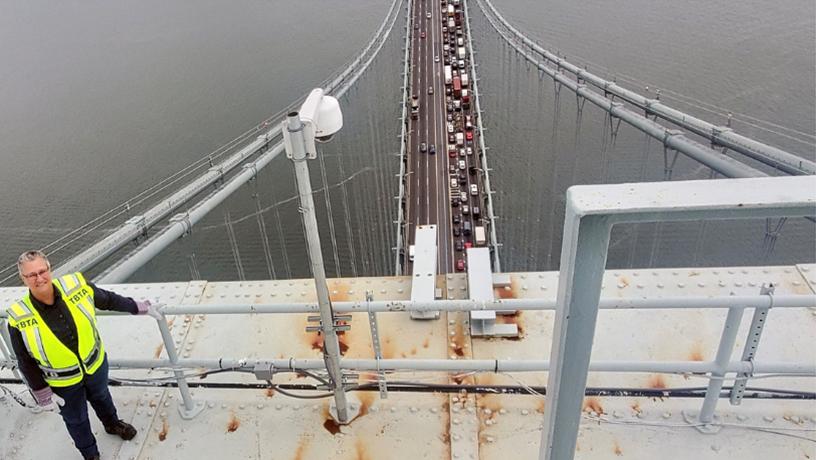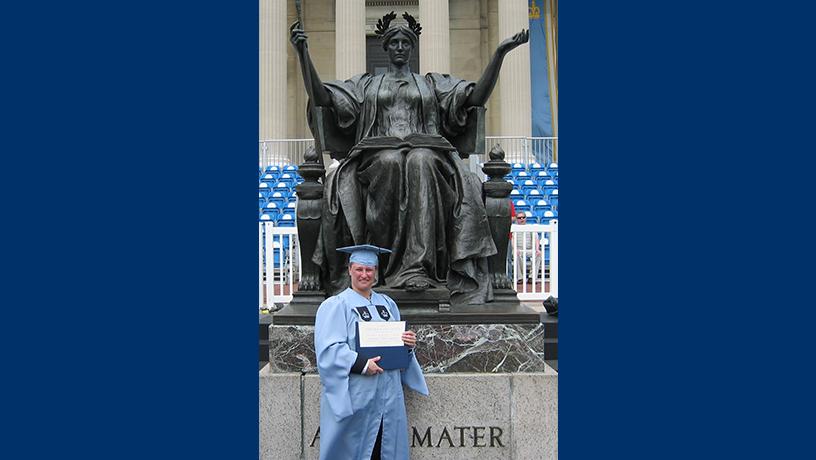Over and Under: Navigating New York’s Infrastructure
Catherine Sheridan MS’07, president at MTA Bridges and Tunnels, is pushing the MTA into a new era.

Catherine Sheridan MS'07 atop the Verrazzano Bridge (Courtesy of Catherine Sheridan)
Getting people in and out of Manhattan is no small job. And that’s where Catherine Sheridan comes in.
Sheridan was named president of the Triborough Bridge and Tunnel Authority (MTA Bridges and Tunnels) in August of 2023, after serving as interim president since March of the same year. And under her eye, the MTA is looking to cut down on pollution, increase revenues, and improve transportation across the city.
In 2023 alone, the Metropolitan Transportation Authority (MTA) estimates that more than 335 million vehicles flowed over and into the seven bridges and two tunnels under its purview, a new record. Getting all those commuters, tourists, workers, daytrippers, residents, and trucks into or off of the island of Manhattan, in fact, is costly, noisy, emissions-heavy, and essential — and getting more so, of all of the above, every day.
Coming for Congestion
One of the biggest campaigns Sheridan will be overseeing at the MTA is congestion pricing, which should roll out later this year.
“We’re over 90 percent complete on infrastructure, and the testing phase is coming quickly – we’re very excited about that,” she said.
A version of congestion pricing was first proposed in 2007 as part of PlaNYC 2030 by the Bloomberg Administration. In 2019, the Governor and the New York State Legislature enacted the MTA Reform and Traffic Mobility Act in 2019, which is expected to dramatically reshape traffic across a broad swath of Manhattan designated the Central Business District (CBD), comprising all of the island below 60th Street. The congestion pricing plan is expected to lead to at least a 10% reduction in how many vehicles enter the CBD daily (or 153,000 fewer people entering the area by car every day), leading to reduced air and noise pollution and substantially improved emergency response time.
The plans haven’t been universally embraced. The proposal has drawn fire from critics for adding an additional economic burden on commuters already squeezed by inflation, and for possibly discouraging people to come into the city during the day, possibly hurting businesses, restaurants, and more.
But Sheridan, and other advocates, point to the benefits. In addition to the reductions in emissions, the increased ease of traveling in the city, and the improved response times for first responders, the congestion pricing plan is expected to generate $15 billion in funding for the MTA annually, earmarked for capital projects like increasing the number of ADA-accessible stations, buying electric buses, and expansion and modernization projects.
While congestion pricing has been rolled out in other major cities including Singapore and London, New York’s launch will be the first time it has been tried in the United States, meaning that the MTA’s efforts will be watched closely as a test case for how it can work nationally.
“We have to launch it and get it started, and then we’ll learn where we need to take it and what we need to change as we go,” she said.
“That money can build a lot of accessible elevators, and buy a lot of electric buses,” she said.
But congestion pricing isn’t the only initiative Sheridan has on her plate. New York’s embrace of open road tolling has meant reductions in accidents and smoother trips with fewer traffic backups. But it’s also meant more people avoiding tolls. Last year, efforts to find and fine serial toll cheats on the MTA’s bridges and tunnels recovered around $110 million – which is money that people both in and outside of New York City benefit from. In addition to maintenance and upkeep on the vital infrastructure of the bridges and tunnels, those revenues directly fund the MTA.
“It’s good for public health,” she said. “There’s a lot of benefits to reducing congestion.”
And while exactly how the program will evolve is yet to be seen, Sheridan is confident in the program’s fundamentals.

Catherine Sheridan, president of MTA Bridges and Tunnels, pictured in front of Alma Mater on the steps of Low Library. (Courtesy of Catherine Sheridan)
Bridges and Tunnels
Sheridan has made New York’s infrastructure her life’s work — but that wasn’t always the plan. After completing a Bachelor of Music in Trumpet Performance from Boston University (yes, she still plays) while serving in the Reserve Officer Training Corps, she completed basic training as a combat engineer. “I discovered I really enjoyed building things,” she said.
Finding career opportunities in the music sphere to be few and far between in upstate New York, Sheridan took a job as a construction inspector for the NYS Department of Transportation to see if she liked it.
She did. “I always say I got a summer job and never left,” she said. “It’s fun to see something get built, and you’re a part of it.”
She spent three years with the Department of Transportation, and spent the next 26 years working progressively more senior jobs at the NYS Thruway Authority and the New York State Canal Corporation. Along the way, she discerned the need to expand her skillset and improve her professional prospects.
“I was looking at how my career could progress, and I wasn’t satisfied with my options,” she said. In 2003, she got her professional engineer’s license, and in 2004, enrolled in Columbia Engineering’s nascent online degree program. Sheridan “jumped on that,” she said, as it opened up an avenue for her to grow her skills even as she continued working full-time upstate. After three years (with her final semester done in person on Columbia’s campus), Sheridan graduated with an M.S. in civil engineering and engineering mechanics.
In 2019, she couldn’t resist a permanent move to the city — the MTA was launching a $55 billion capital program, and “being in on the beginning of that was really exciting,” she said.
Looking back – and looking ahead
Sheridan started her role as project manager, transformation at MTA Construction & Development in October of 2019. Less than five months later, the first cases of covid-19 were identified in NYC, and the job suddenly became very different.
“Shutting down construction at the MTA was not an option,” she said. “This was huge for the economy. We had to do it safely, but keep it moving.”
The experience was a “baptism by fire,” she said – but the learnings she took from it have influenced her to this day.
“Getting through the pandemic and completing the projects had nothing to do with engineering; it had to do with communication,” she said. “Every day, information changed as we learned how to deal with a pandemic we knew nothing about. There was no playbook. But we’re better equipped now.”
Getting better equipped was the whole reason that Sheridan first chose to pursue a degree at Columbia.
The online degree program in 2004 was much less interactive, she said, watching recordings and submitting coursework. But the lineup of instructors — including a number of industry professionals — brought their real-life project experiences to the courses, and that “put a seed in my head that you could do this, too, one day,” Sheridan said. One professor, she said, asked the class to write a paragraph or two about where students were then, and where they wanted to go.
Suffice it to say, “leading MTA Bridges and Tunnels” was not on the list — but that seed that was planted couldn’t be ignored.
“I couldn’t have predicted any of it,” Sheridan said. “Back then, I thought, ‘I’m gonna be a director of canal operations and I’m gonna retire from that.’ It’s amazing the different roads you take.”
